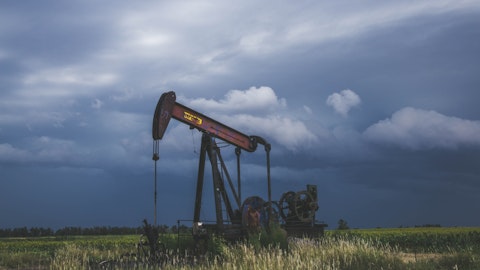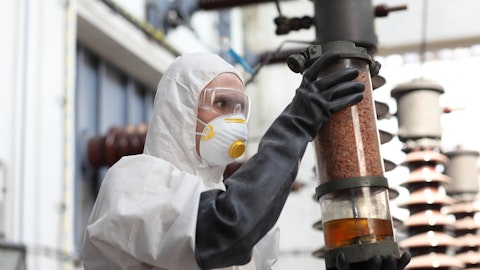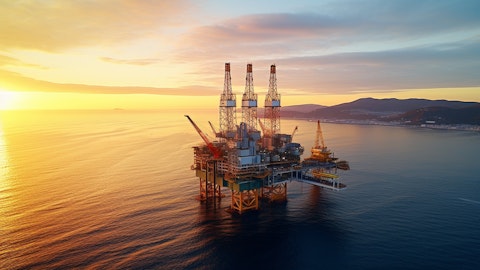Paul Cheng: Two questions. One is really short. Maybe it’s for Jean-Pierre. Third quarter E&P, the effective tax rate, they call it wrong number, 45%, seems a bit low, even thing into consideration of the lower contribution from North Sea. Is there any one-off benefit in tax in the quarter? And also more importantly, that based on the current market conditions, what is your expectation for the division, the effective tax rate in the fourth quarter? Second question, I think this is for Patrick. We have seen a pretty substantial reduction in the renewable diesel margin over the past several weeks and that the wind price in the U.S. has been dropping. And we have also seen the LCFS supply remain relatively low. That’s this market condition in any shape or form will impact your thinking of the investment in the alternative fuel by renewable diesel and SAF?
Patrick Pouyanne: In fact, as Jean-Pierre told you the first question, it’s not only the mix, the lower [indiscernible] is the fact that it’s more important, and we’ll come back to you, I think in February, that the new barrels that we are producing like in Brazil, like in Iraq, like I think there was another example in Europe.
Jean-Pierre Sbraire: Azerbaijan?
Patrick Pouyanne: In Azerbaijan. In fact, have a lower fiscal burden than the declining barrels from the North Sea. So it’s interesting for you because that means that there is a trend in our portfolio with new barrels and higher margins through lower tax. To give you the real figure for Q4, I mean, it’s premature. I cannot guess on that. As you know, we are making quarterly results. In January, the last quarter, you have some alignment. But to come back, is there any 1 — no, no, Jean-Pierre confirmed.
Jean-Pierre Sbraire: I mentioned them to the 2 main factors in my speech. So once again, the weighted average high barriers versus — high tax barrel versus low-cost barrels. And the fact that we are now more attractive barrels in our portfolio.
Patrick Pouyanne: So there was no one. On the second one, the U.S. refining market and LCFS, obviously, as you noticed, as you probably noticed, [indiscernible] was not really running in the Q3. We had an issue. So I’ve been — we have more work here on restarting for offer with this long haul, and it will restart by mid November by taking care of the margins in the U.S. because, unfortunately, when the refinery is not working, there is no margin to capture. So I think for me, from my [indiscernible], I will dig, thank you for the question. But I still see every day, quite a high margin in the U.S., even if it’s lower, again, like in Europe, we went to the roof, which was around almost not far from $200 per ton, I think, which we’ve never seen since I am in this company during 1 quarter.
It’s softening today, but it’s softening, remaining around 120, 150, so it’s still very high. Does it affect the renewable diesel and stuff? No. Because in fact, all these businesses today, they are regulated, in fact, they are somewhere regulated. And somewhere in Europe, in particular, in the end, the stock price is more guided by the penalty that somebody will pay if it does not fill the mandate rather than the demand and supply. Because today, in fact, on the stock. So supply is short of the demand somewhere. So you’re still running behind. So it’s more — it’s a regulated business somewhere. And as the penalty are quite high, it does not impact this directly as a business. In the U.S., we don’t make [indiscernible] today. So I’m not able to come back to you on this one.
We plan to produce [indiscernible] in the future in [indiscernible], but we don’t do it today. So I can’t help you to understand the mix market in the U.S. today specifically.
Operator: The next question is from Jean-Luc Romain of CIC Market Solutions.
Jean-Luc Romain: It relates to your acquisition in Germany. I was wondering with the electricity that you will purchase on medium-term contracts, will be accounted for in your kind of power capacity or in your power sales will that work? Or will it be only an intermediary margin?
Patrick Pouyanne: It will be a sale, but not a capacity. We don’t own the capacity. We manage the capacity. As you know, we are honest people. So we don’t invest in the capacity, but we have access to some capacities, which is a good thing. And then we give the sales because we are selling it for sure. We are selling it to customers, and we might have even — I think in the portfolio, we have 2 gigawatts out of the 9 gigawatts, which are under medium, long-term PPAs, so that sales, which will be reported as sales but not as capacities because we don’t earn all the capacities. So that’s the way it will work. Like in LNG, you have some reporting in the sales, and we don’t report when we have — it’s like a long-term PPA, SPA that we have with the U.S. LNG [indiscernible] we don’t account for the capacity in our production because we don’t produce it, but we account in the sales, same mechanics [indiscernible] is the right one, by the way.
Operator: The next question is from Jason Gabelman of TD Cohen.
Jason Gabelman: Just one follow-up on CapEx. I think you mentioned both the oil sands divestment and the sale to [indiscernible] would close in 4Q, which implies about $6 billion of divestment proceeds coming in and in light of that, it seems like reiterating the $16 billion to $17 billion CapEx range for 2023 would be a bit high. So I was hoping you just could square those 2?
Patrick Pouyanne: Well, no, it’s not high. No, because it’s not so high because you — we spend organically $5 billion, $6 billion per quarter. We are today at the end of the quarter . We spent $5 billion to $6 billion per quarter. We’ll divest, but we have 1 or 2 acquisitions that I mentioned, which are coming in the quarter as well. So $16 billion, $17 billion seems to be — it’s not $16 billion, $18 billion. By the way, we specified $16 billion, $17 billion this morning. So we — I think the $16 billion, $17 billion seems to be to us the right range. But we will explain to you that in the annual [indiscernible]. So take it as — I think we have a good view on where we should land.
Operator: The next question comes from Alessandro Pozzi of Mediobanca.
Alessandro Pozzi: Just one question on the macro side. And I guess, in a way, it’s linked to the recent offtake agreement in Qatar. This week, the IEA has published the world energy outlook and the downgraded again, the gas demand for 2050. I think if you look at the EPS, it’s down 40% gas demand. I was wondering, is this versus 2022? Is this a concern for you blocking such long-term contracts? Or do you think the IEA remains hard to bearish on gas demand?
Patrick Pouyanne: No. It’s — I would tell you — I don’t know who is right [indiscernible] the matter of IEA, it’s a matter of positioning of your projects. In fact, for me, all that is driven by the position of — in the cost merit curve of the investment in Qatar. In Qatar, you are first quartile. So I can tell you, producing LNG in Qatar even by 2050, which would be more efficient than in many places around the planet. So even if there is a reduction of 40%, you still have 60%. And in the 60%, Qatar will be perfectly positioned. So in fact, let’s be clear, and this is the whole strategy of the company, to protect all our — because you need to make long-term investments in energy and in particular energy. But [indiscernible] all, the philosophy all our portfolio is guided by low-cost first quartile assets because there whatever will happen on the demand either the demand will diminish as planned by IEA.
We are protected you — as investors are tested. There is no problem. So my answer to you is yes, there are certainty of the demand on oil and the demand of gas and the demand of electricity. The key driver of the world strategy is driven by the [indiscernible] and they are having first quartile projects, and I can demonstrate the Qatar projects are among the best of the world, if not the best. And everybody knows that because it’s a huge gas still produced 50-meter water depths conventional with quite a high content of condensate, as you all know. So at the end, it makes this project very resilient. And even in 2050, we will produce and even beyond because the IEA does not tell you there is no gas. There is still maybe 60%, maybe 70%, maybe 50%, we’ll see.





